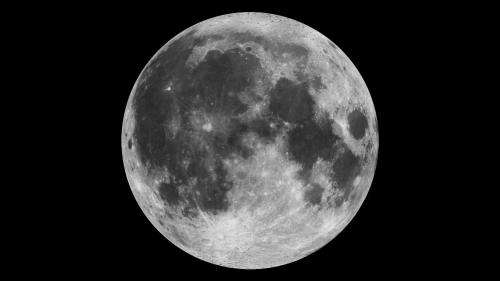Mosaic of the near side of the moon as taken by the Clementine star trackers. The images were taken on March 15, 1994. Credit: NASA
When can people expect to live and work in space? That is quite a question, but scientists are not afraid of asking yet another: assuming people are living and working in space, how are they to communicate with space stations and individuals on Earth? Can they reasonably expect reliable wireless Internet access on the moon? The answer from a team of scientists at NASA and the Massachusetts Institute of Technology is that it may well be possible, namely, that wireless broadband can reach the moon. The researchers are from MIT's Lincoln Laboratory, working with NASA, forming a "lunar laser communication" team. They are to present a report of a laser-based communication uplink between the moon and Earth, which beat a previous record transmission speed last fall by a factor of 4,800. A detailed overview of their work was prepared by The Optical Society (OSA); the team will be taking their findings next month to the Conference on Lasers and Electro-Optics (CLEO) in California, on June 9.
The scientists have demonstrated a data communication technology approach that can provide space dwellers with connectivity, enabling large data transfers and even high-definition video streaming. What is this approach to bringing connectivity to the moon all about? The team used four separate telescopes at a ground terminal at White Sands, New Mexico. The telescopes, each about 6 inches in diameter, send the uplink signal to the moon. Each telescope is fed by a laser transmitter sending information coded as pulses of invisible infrared light.
The researchers use four telescopes, as each transmits light through a different column of air which experiences different bending effects from the atmosphere, raising the chance of at least one of the beams to interact with the receiver, mounted on a satellite orbiting the moon. The receiver's telescope collects the light, focused into an optical fiber. "From there," said OSA, "the signal in the fiber is amplified about 30,000 times. A photodetector converts the pulses of light into electrical pulses that are in turn converted into data bit patterns that carry the transmitted message. Of the 40-watt signals sent by the transmitter, less than a billionth of a watt is received at the satellite—but that's still about 10 times the signal necessary to achieve error-free communication."
Mark Stevens of MIT Lincoln Laboratory said communicating at high data rates from Earth to the moon with laser beams poses a challenge because of the 400,000-kilometer distance spreading out the light beam. He said that it is "doubly difficult going through the atmosphere, because turbulence can bend light-causing rapid fading or dropouts of the signal at the receiver."
The receiver's telescope collects the light, focused into an optical fiber. "From there," said OSA, "the signal in the fiber is amplified about 30,000 times. A photodetector converts the pulses of light into electrical pulses that are in turn converted into data bit patterns that carry the transmitted message. Of the 40-watt signals sent by the transmitter, less than a billionth of a watt is received at the satellite—but that's still about 10 times the signal necessary to achieve error-free communication."
© 2014 Tech Xplore
























